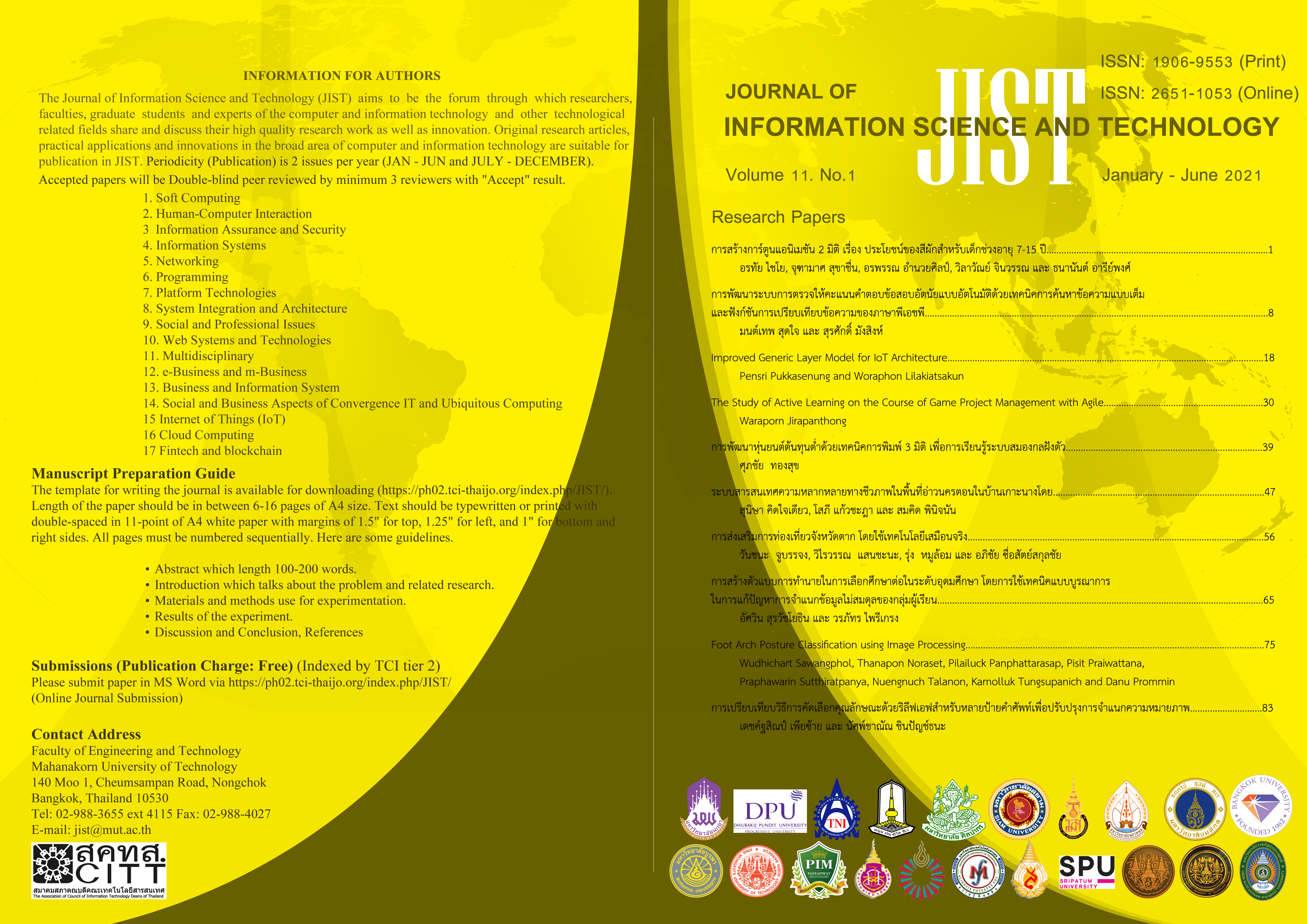Tourism Promotion in Tak Province using Virtual Reality Technology
Main Article Content
Abstract
The purpose of this study is to develop digital media, that has been applied the virtual reality technology, for tourism promotion in Tak province. This technology is an attractive tool to create simulated three-dimensional images or environments. It can build the tourists’ feel that they are similar in real places. The information was collected from the relevant expert. The digital media were developed using the unity application and virtual reality tools that help tourists to know the shape, proportion, and virtual display. These digital media and information about the attraction were presented together on web applications. The results of this evaluation showed that the users were satisfied with the digital media and web application at the highly level of satisfaction (x ̅ = 4.43, S.D. = .550).
Article Details
This work is licensed under a Creative Commons Attribution-NonCommercial-NoDerivatives 4.0 International License.
I/we certify that I/we have participated sufficiently in the intellectual content, conception and design of this work or the analysis and interpretation of the data (when applicable), as well as the writing of the manuscript, to take public responsibility for it and have agreed to have my/our name listed as a contributor. I/we believe the manuscript represents valid work. Neither this manuscript nor one with substantially similar content under my/our authorship has been published or is being considered for publication elsewhere, except as described in the covering letter. I/we certify that all the data collected during the study is presented in this manuscript and no data from the study has been or will be published separately. I/we attest that, if requested by the editors, I/we will provide the data/information or will cooperate fully in obtaining and providing the data/information on which the manuscript is based, for examination by the editors or their assignees. Financial interests, direct or indirect, that exist or may be perceived to exist for individual contributors in connection with the content of this paper have been disclosed in the cover letter. Sources of outside support of the project are named in the cover letter.
I/We hereby transfer(s), assign(s), or otherwise convey(s) all copyright ownership, including any and all rights incidental thereto, exclusively to the Journal, in the event that such work is published by the Journal. The Journal shall own the work, including 1) copyright; 2) the right to grant permission to republish the article in whole or in part, with or without fee; 3) the right to produce preprints or reprints and translate into languages other than English for sale or free distribution; and 4) the right to republish the work in a collection of articles in any other mechanical or electronic format.
We give the rights to the corresponding author to make necessary changes as per the request of the journal, do the rest of the correspondence on our behalf and he/she will act as the guarantor for the manuscript on our behalf.
All persons who have made substantial contributions to the work reported in the manuscript, but who are not contributors, are named in the Acknowledgment and have given me/us their written permission to be named. If I/we do not include an Acknowledgment that means I/we have not received substantial contributions from non-contributors and no contributor has been omitted.
References
N. Surawattananon, “Thailand Tourism: A hero is necessary or a true hero?,” October, 2019. [Online], Available: https://www.bangkokbiznews.com/ blog/detail/648600 [Accessed Mar. 9, 2020].
P. Nilsuk, “Web assessment teaching help,” 2003. [Online]. Available: http://campus.fortunecity.com/ purdue/219/index.html. [Accessed Mar. 9, 2020].
P. Udom, “A development virtual reality technology for tourism Case study of Hua-Hin tourism,” M.S. thesis, Bangkok University, Bangkok, 2017.
A. Kangsawat, K. Thadchan, P. Sommai, A. Sitthidet and N. Saikatikorn, “The Development of Cultural Tourism Website in Phetchaburi Province Using Augmented Reality,” In Proc. The 4th National RMUTR Conference and the 1st International RMUTR Conference, 2019.
S. Wiriya, A. Sukpradit and R. Thongkongyu, “The Development Augmented Reality Cultural Tourism in Nakhon Sawan Province,” In Proc. The 4th National Academic Conference, Kamphaengphet University, Research Institute, Kamphaengphet, 2017.
A. Sripramai and P. Limpinan, “The development of virtual reality technology to promote tourism at Wat Mahathat,” In Proc. The 5th ASEAN Undergraduate Conference in Computing (AUC2), Naresuan University, Phitsanulok, 2017.
K. Jiraboot, W. Nanglae, S. Jaihuek, P. Jitkham, K. Phikun, T. Chaichombhoo, T. Yuyen and B. Wetpichetkoso, “The Creating Media Tourist Map by using Augmented Reality Technology for Promote Tourism District Chiang Khong Province Chiang Rai,” In Proc. National research presentations Graduate Network 17th Northern Rajabhat University, 2017.
W. Phromun, “Virtual Reality Technology,” 2008. [Online]. Available: https://www.docstoc.com/docs /28427384/Virtual-Reality-Technology. [Accessed Mar. 9, 2020].
A.kampliw, C. Chalermsuk and G. Chuamsombat, “Development of Thailand Tourism Application Using Virtual Reality Technology,” In Proc. The 2nd University of the Thai Chamber of Commerce, 2018.
D. Srifar, “Virtual reality for tourism promoting of koh pha-ngan,” Research, Rajamangala University of Technology Phra Nakhon, 2019.



